Radiometric Cross-Calibration and Validation of KOMPSAT-3/AEISS Using Sentinel-2A/MSI
Abstract
Highlights
- Cross-calibration with Sentinel-2A/MSI, applying SBAF and BRDF corrections, yielded gains of 0.0196 (Blue), 0.0237 (Green), 0.0214 (Red), and 0.0136 (NIR), consistent with prior KOMPSAT-3 studies.
- Five vicarious calibration campaigns at the KARI site produced gains of 0.0217 (Blue), 0.0299 (Green), 0.0221 (Red), and 0.0155 (NIR), demonstrating consistency with earlier studies.
- Both cross and vicarious calibration confirm that KOMPSAT-3/AEISS has maintained stable radiometric coefficients over more than a decade of operation.
- These traditional calibration results suggest the potential to extend toward emerging methodologies based on machine learning and deep learning.
Abstract
1. Introduction
2. Materials and Methods
2.1. Satellite
2.2. Calibration Site
2.3. Cross-Calibration Method
2.4. Vicarious Calibration Method
3. Results and Discussion
3.1. Cross-Calibration
3.2. Vicarious Calibration
3.3. Validation
4. Conclusions
Author Contributions
Funding
Data Availability Statement
Conflicts of Interest
References
- Baraldi, A. Impact of radiometric calibration and specifications of spaceborne optical imaging sensors on the development of operational automatic remote sensing image understanding systems. IEEE J. Sel. Top. Appl. Earth Obs. Remote Sens. 2009, 2, 104–134. [Google Scholar] [CrossRef]
- Chander, G.; Hewison, T.J.; Fox, N.; Wu, X.; Xiong, X.; Blackwell, W.J. Overview of intercalibration of satellite instruments. IEEE Trans. Geosci. Remote Sens. 2013, 51, 1056–1080. [Google Scholar] [CrossRef]
- Kabir, S.; Leigh, L.; Helder, D. Vicarious methodologies to assess and improve the quality of the optical remote sensing images: A critical review. Remote Sens. 2020, 12, 4029. [Google Scholar] [CrossRef]
- Khakurel, P.; Leigh, L.; Kaewmanee, M.; Pinto, C.T. Extended pseudo invariant calibration site-based trend-to-trend cross-calibration of optical satellite sensors. Remote Sens. 2021, 13, 1545. [Google Scholar] [CrossRef]
- Chen, Z.; Zhang, B.; Zhang, H.; Zhang, W. Vicarious calibration of Beijing-1 multispectral imagers. Remote Sens. 2014, 6, 1432–1450. [Google Scholar] [CrossRef]
- Datla, R.; Rice, J.P.; Lykke, K.R.; Johnson, B.C.; Butler, J.J.; Xiong, X. Best practice guidelines for pre-launch characterization and calibration of instruments for passive optical remote sensing. J. Res. Natl. Inst. Stand. Technol. 2011, 116, 621. [Google Scholar] [CrossRef] [PubMed]
- Chander, G.; Meyer, D.J.; Helder, D.L. Cross calibration of the Landsat-7 ETM+ and EO-1 ALI sensor. IEEE Trans. Geosci. Remote Sens. 2004, 42, 2821–2831. [Google Scholar] [CrossRef]
- Chander, G.; Mishra, N.; Helder, D.L.; Aaron, D.B.; Angal, A.; Choi, T.; Xiong, X.; Doelling, D.R. Applications of spectral band adjustment factors (SBAF) for cross-calibration. IEEE Trans. Geosci. Remote Sens. 2012, 51, 1267–1281. [Google Scholar] [CrossRef]
- Li, S.; Ganguly, S.; Dungan, J.L.; Wang, W.; Nemani, R.R. Sentinel-2 MSI radiometric characterization and cross-calibration with Landsat-8 OLI. Adv. Remote Sens. 2017, 6, 147. [Google Scholar] [CrossRef]
- Barsi, J.A.; Alhammoud, B.; Czapla-Myers, J.; Gascon, F.; Haque, M.O.; Kaewmanee, M.; Leigh, L.; Markham, B.L. Sentinel-2A MSI and Landsat-8 OLI radiometric cross comparison over desert sites. Eur. J. Remote Sens. 2018, 51, 822–837. [Google Scholar] [CrossRef]
- Dong, J.; Chen, Y.; Chen, X.; Xu, Q. Radiometric Cross-Calibration of Wide-Field-of-View Cameras Based on Gaofen-1/6 Satellite Synergistic Observations Using Landsat-8 Operational Land Imager Images: A Solution for Off-Nadir Wide-Field-of-View Associated Problems. Remote Sens. 2023, 15, 3851. [Google Scholar] [CrossRef]
- Li, X.; Strahler, A.H. Geometric-optical bidirectional reflectance modeling of the discrete crown vegetation canopy: Effect of crown shape and mutual shadowing. IEEE Trans. Geosci. Remote Sens. 1992, 30, 276–292. [Google Scholar] [CrossRef]
- Yeom, J.-M.; Ko, J.; Hwang, J.; Lee, C.-S.; Choi, C.-U.; Jeong, S. Updating absolute radiometric characteristics for KOMPSAT-3 and KOMPSAT-3A multispectral imaging sensors using well-characterized pseudo-invariant tarps and microtops II. Remote Sens. 2018, 10, 697. [Google Scholar] [CrossRef]
- Ahn, H.; Shin, D.; Lee, S.; Choi, C. Absolute Radiometric Calibration for KOMPSAT-3 AEISS and Cross Calibration Using Landsat-8 OLI. J. Korean Soc. Surv. Geod. Photogramm. Cartogr. 2017, 35, 291–302. [Google Scholar]
- Jin, C.; Ahn, H.; Seo, D.; Choi, C. Radiometric calibration and uncertainty analysis of KOMPSAT-3A using the reflectance-based method. Sensors 2020, 20, 2564. [Google Scholar] [CrossRef]
- Ma, L.; Zhao, Y.; Woolliams, E.R.; Dai, C.; Wang, N.; Liu, Y.; Li, L.; Wang, X.; Gao, C.; Li, C. Uncertainty analysis for RadCalNet instrumented test sites using the Baotou sites BTCN and BSCN as examples. Remote Sens. 2020, 12, 1696. [Google Scholar] [CrossRef]
- Han, J.; Tao, Z.; Xie, Y.; Li, H.; Yi, H.; Guan, X. Validation of the TOA products of the baotou sandy site with Landsat8/OLI considering BRDF correction. IEEE Trans. Geosci. Remote Sens. 2023, 61, 5401611. [Google Scholar] [CrossRef]
- Jing, X.; Leigh, L.; Helder, D.; Pinto, C.T.; Aaron, D. Lifetime absolute calibration of the EO-1 Hyperion sensor and its validation. IEEE Trans. Geosci. Remote Sens. 2019, 57, 9466–9475. [Google Scholar] [CrossRef]
- Jeon, M.-J.; Lee, S.-R.; Kim, E.; Lim, S.-B.; Choi, S.-W. Launch and early operation results of KOMPSAT-3A. In Proceedings of the 14th International Conference on Space Operations, Daejeon, Republic of Korea, 16–20 May 2016; p. 2394. [Google Scholar]
- Lee, S.-J.; Lee, Y.-W. Detection of wildfire-damaged areas using kompsat-3 image: A case of the 2019 unbong mountain fire in busan, South Korea. Korean J. Remote Sens. 2020, 36, 29–39. [Google Scholar]
- Lee, K.-J.; Chae, T.-B.; Jung, H.-S. Earth observation from KOMPSAT optical, thermal, and radar satellite images. Remote. Sens. 2021, 13, 139. [Google Scholar] [CrossRef]
- Che, X.; Feng, M.; Sexton, J.O.; Channan, S.; Yang, Y.; Sun, Q. Assessment of MODIS BRDF/Albedo model parameters (MCD43A1 Collection 6) for directional reflectance retrieval. Remote Sens. 2017, 9, 1123. [Google Scholar] [CrossRef]
- Spurr, R.J. A new approach to the retrieval of surface properties from earthshine measurements. J. Quant. Spectrosc. Radiat. Transf. 2004, 83, 15–46. [Google Scholar] [CrossRef]
- Jin, C.; Choi, C. The assessment of cross calibration/validation accuracy for KOMPSAT-3 using Landsat 8 and 6S. Korean J. Remote Sens. 2021, 37, 123–137. [Google Scholar]
- Zhang, J.; Zhou, X.; Liu, X.; Wang, X.; He, G.; Zhang, Y. Harmonizing Landsat-8 OLI and Sentinel-2 MSI: An assessment of surface reflectance and vegetation index consistency. Int. J. Digit. Earth 2025, 18, 2484667. [Google Scholar] [CrossRef]
- Lima, T.M.; Martins, V.S.; Paulino, R.S.; Caballero, C.B.; Maciel, D.A.; Giardino, C. A general spectral bandpass adjustment function (SBAF) for harmonizing landsat-sentinel over inland and coastal waters. Sci. Remote Sens. 2025, 11, 100225. [Google Scholar] [CrossRef]
- Yeom, J.-M.; Hwang, J.; Jin, C.-G.; Lee, D.-H.; Han, K.-S. Radiometric characteristics of KOMPSAT-3 multispectral images using the spectra of well-known surface tarps. IEEE Trans. Geosci. Remote Sens. 2016, 54, 5914–5924. [Google Scholar] [CrossRef]
- Drusch, M.; Del Bello, U.; Carlier, S.; Colin, O.; Fernandez, V.; Gascon, F.; Hoersch, B.; Isola, C.; Laberinti, P.; Martimort, P. Sentinel-2: ESA’s optical high-resolution mission for GMES operational services. Remote Sens. Environ. 2012, 120, 25–36. [Google Scholar] [CrossRef]
- Transon, J.; d’Andrimont, R.; Maugnard, A.; Defourny, P. Survey of hyperspectral earth observation applications from space in the sentinel-2 context. Remote Sens. 2018, 10, 157. [Google Scholar] [CrossRef]
- Pahlevan, N.; Sarkar, S.; Franz, B.A.; Balasubramanian, S.V.; He, J. Sentinel-2 MultiSpectral Instrument (MSI) data processing for aquatic science applications: Demonstrations and validations. Remote Sens. Environ. 2017, 201, 47–56. [Google Scholar] [CrossRef]
- Kuc, G.; Chormański, J. Sentinel-2 imagery for mapping and monitoring imperviousness in urban areas. Int. Arch. Photogramm. Remote Sens. Spat. Inf. Sci. 2019, 42, 43–47. [Google Scholar] [CrossRef]
- Phiri, D.; Simwanda, M.; Salekin, S.; Nyirenda, V.R.; Murayama, Y.; Ranagalage, M. Sentinel-2 data for land cover/use mapping: A review. Remote Sens. 2020, 12, 2291. [Google Scholar] [CrossRef]
- Kudela, R.M.; Hooker, S.B.; Houskeeper, H.F.; McPherson, M. The influence of signal to noise ratio of legacy airborne and satellite sensors for simulating next-generation coastal and inland water products. Remote Sens. 2019, 11, 2071. [Google Scholar] [CrossRef]
- Thome, K.J.; Biggar, S.F.; Wisniewski, W. Cross comparison of EO-1 sensors and other Earth resources sensors to Landsat-7 ETM+ using Railroad Valley Playa. IEEE Trans. Geosci. Remote Sens. 2003, 41, 1180–1188. [Google Scholar] [CrossRef]
- Marcq, S.; Meygret, A.; Bouvet, M.; Fox, N.; Greenwell, C.; Scott, B.; Berthelot, B.; Besson, B.; Guilleminot, N.; Damiri, B. New RadCalNet site at Gobabeb, Namibia: Installation of the instrumentation and first satellite calibration results. In Proceedings of the IGARSS 2018—2018 IEEE International Geoscience and Remote Sensing Symposium, Valencia, Spain, 22–27 July 2018; pp. 6444–6447. [Google Scholar]
- Kneubühler, M.; Schaepman, M.E.; Thome, K.; Danesy, D. Long-term vicarious calibration efforts of MERIS at railroad valley playa (NV)-An update. In ESA-SP; online; European Space Agency: Paris, France, 2006. [Google Scholar]
- Kuze, A.; O’Brien, D.M.; Taylor, T.E.; Day, J.O.; O’Dell, C.W.; Kataoka, F.; Yoshida, M.; Mitomi, Y.; Bruegge, C.J.; Pollock, H. Vicarious calibration of the GOSAT sensors using the Railroad Valley desert playa. IEEE Trans. Geosci. Remote Sens. 2010, 49, 1781–1795. [Google Scholar] [CrossRef]
- Scott, K.P.; Thome, K.J.; Brownlee, M.R. Evaluation of Railroad Valley playa for use in vicarious calibration. In Multispectral Imaging for Terrestrial Applications; SPIE—The International Society for Optical Engineering: Bellingham, WA, USA, 1996; pp. 158–166. [Google Scholar]
- Göttsche, F.-M.; Olesen, F.-S.; Bork-Unkelbach, A. Validation of land surface temperature derived from MSG/SEVIRI with in situ measurements at Gobabeb, Namibia. Int. J. Remote Sens. 2013, 34, 3069–3083. [Google Scholar] [CrossRef]
- Marcq, S.; Meygret, A.; Bialek, A.; Greenwell, C.; Scott, B.; Fox, N.; Bouvet, M.; Berthelot, B.; Damiri, B. New RadCalNet Instrumented Site at Gobabeb, Namibia: Installation Field Campaign and First Absolute Calibration Results. 2017. Available online: https://digitalcommons.usu.edu/calcon/CALCON2017/All2017Content/5/ (accessed on 19 September 2025).
- Jin, Y.; Schaaf, C.B.; Gao, F.; Li, X.; Strahler, A.H.; Lucht, W.; Liang, S. Consistency of MODIS surface bidirectional reflectance distribution function and albedo retrievals: 1. Algorithm performance. J. Geophys. Res. Atmos. 2003, 108. [Google Scholar] [CrossRef]
- Strahler, A.H.; Muller, J.; Lucht, W.; Schaaf, C.; Tsang, T.; Gao, F.; Li, X.; Lewis, P.; Barnsley, M.J. MODIS BRDF/albedo product: Algorithm theoretical basis document version 5.0. MODIS Doc. 1999, 23, 42–47. [Google Scholar]
- Ju, J.; Roy, D.P.; Shuai, Y.; Schaaf, C. Development of an approach for generation of temporally complete daily nadir MODIS reflectance time series. Remote Sens. Environ. 2010, 114, 1–20. [Google Scholar] [CrossRef]
- Schaaf, C.B.; Gao, F.; Strahler, A.H.; Lucht, W.; Li, X.; Tsang, T.; Strugnell, N.C.; Zhang, X.; Jin, Y.; Muller, J.-P. First operational BRDF, albedo nadir reflectance products from MODIS. Remote Sens. Environ. 2002, 83, 135–148. [Google Scholar] [CrossRef]
- Feng, L.; Li, J.; Gong, W.; Zhao, X.; Chen, X.; Pang, X. Radiometric cross-calibration of Gaofen-1 WFV cameras using Landsat-8 OLI images: A solution for large view angle associated problems. Remote Sens. Environ. 2016, 174, 56–68. [Google Scholar] [CrossRef]
- Farhad, M.M.; Kaewmanee, M.; Leigh, L.; Helder, D. Radiometric cross calibration and validation using 4 angle BRDF model between landsat 8 and sentinel 2A. Remote Sens. 2020, 12, 806. [Google Scholar] [CrossRef]
- Pan, Z.; Zhang, H.; Min, X.; Xu, Z. Vicarious calibration correction of large FOV sensor using BRDF model based on UAV angular spectrum measurements. J. Appl. Remote Sens. 2020, 14, 027501. [Google Scholar] [CrossRef]
- Zhong, B.; Ma, Y.; Yang, A.; Wu, J. Radiometric performance evaluation of FY-4A/AGRI based on Aqua/MODIS. Sensors 2021, 21, 1859. [Google Scholar] [CrossRef] [PubMed]
- Bouvet, M.; Thome, K.; Berthelot, B.; Bialek, A.; Czapla-Myers, J.; Fox, N.P.; Goryl, P.; Henry, P.; Ma, L.; Marcq, S. RadCalNet: A radiometric calibration network for Earth observing imagers operating in the visible to shortwave infrared spectral range. Remote Sens. 2019, 11, 2401. [Google Scholar] [CrossRef]
- Liu, L.; Shi, T.; Gao, H.; Zhang, X.; Han, Q.; Hu, X. Long-term cross calibration of HJ-1A CCD1 and Terra MODIS reflective solar bands. Sci. Rep. 2021, 11, 7386. [Google Scholar] [CrossRef]
- Jin, Y.; Schaaf, C.B.; Woodcock, C.E.; Gao, F.; Li, X.; Strahler, A.H.; Lucht, W.; Liang, S. Consistency of MODIS surface bidirectional reflectance distribution function and albedo retrievals: 2. Validation. J. Geophys. Res. Atmos. 2003, 108. [Google Scholar] [CrossRef]
- Ding, A.; Jiao, Z.; Zhang, X.; Dong, Y.; Kokhanovsky, A.A.; Guo, J.; Jiang, H. A practical approach to improve the MODIS MCD43A products in snow-covered areas. J. Remote Sens. 2023, 3, 0057. [Google Scholar] [CrossRef]
- Berk, A.; Hawes, F. Validation of MODTRAN® 6 and its line-by-line algorithm. J. Quant. Spectrosc. Radiat. Transf. 2017, 203, 542–556. [Google Scholar] [CrossRef]
- Berk, A.; Anderson, G.; Acharya, P.; Shettle, E. MODTRAN5: A Reformulated Atmospheric Band Model with Auxiliary Species and Advanced Multiple Scattering Options; Spectral Sciences, Inc.: Burlington, MA, USA, 2011. [Google Scholar]
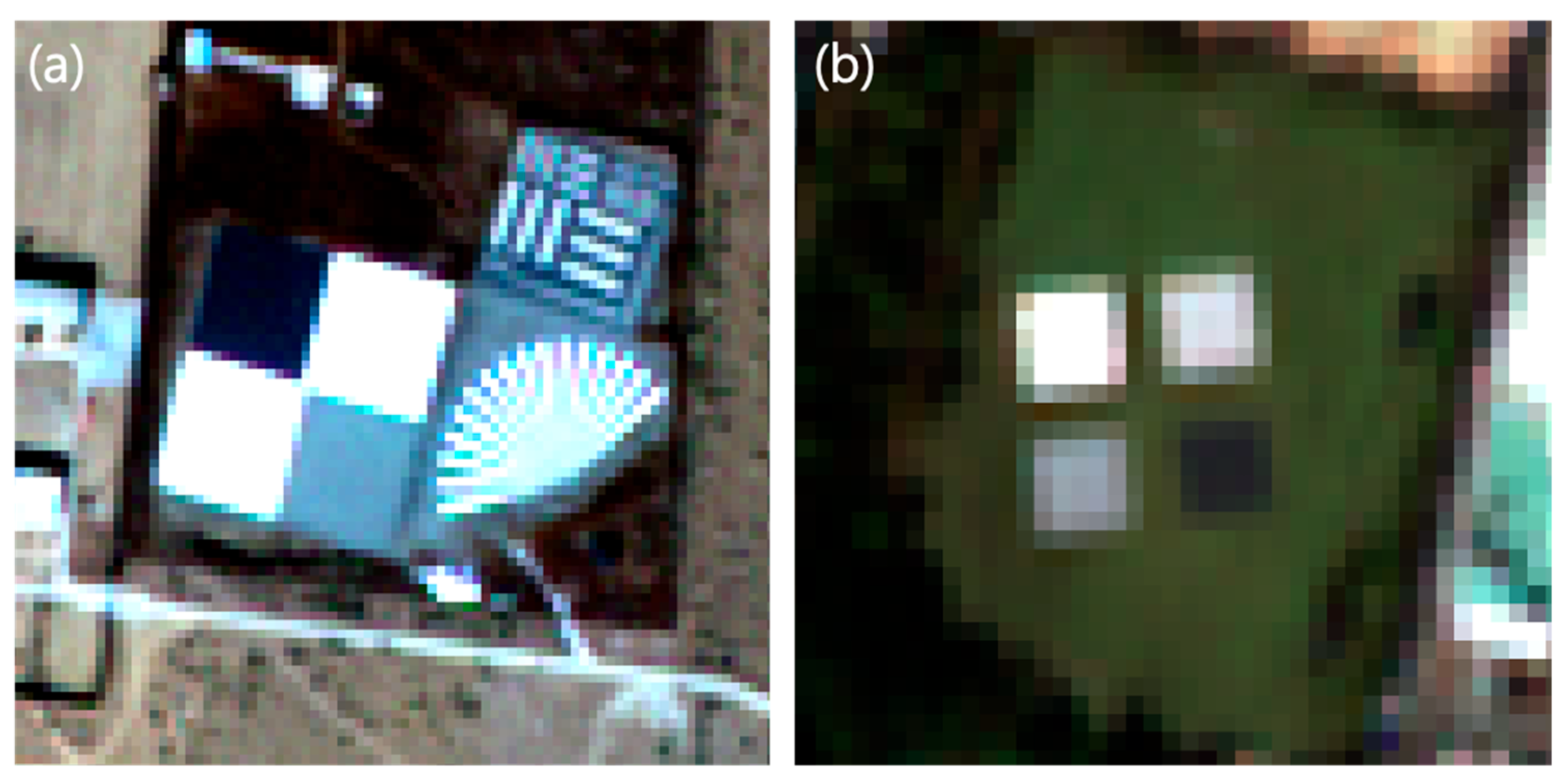
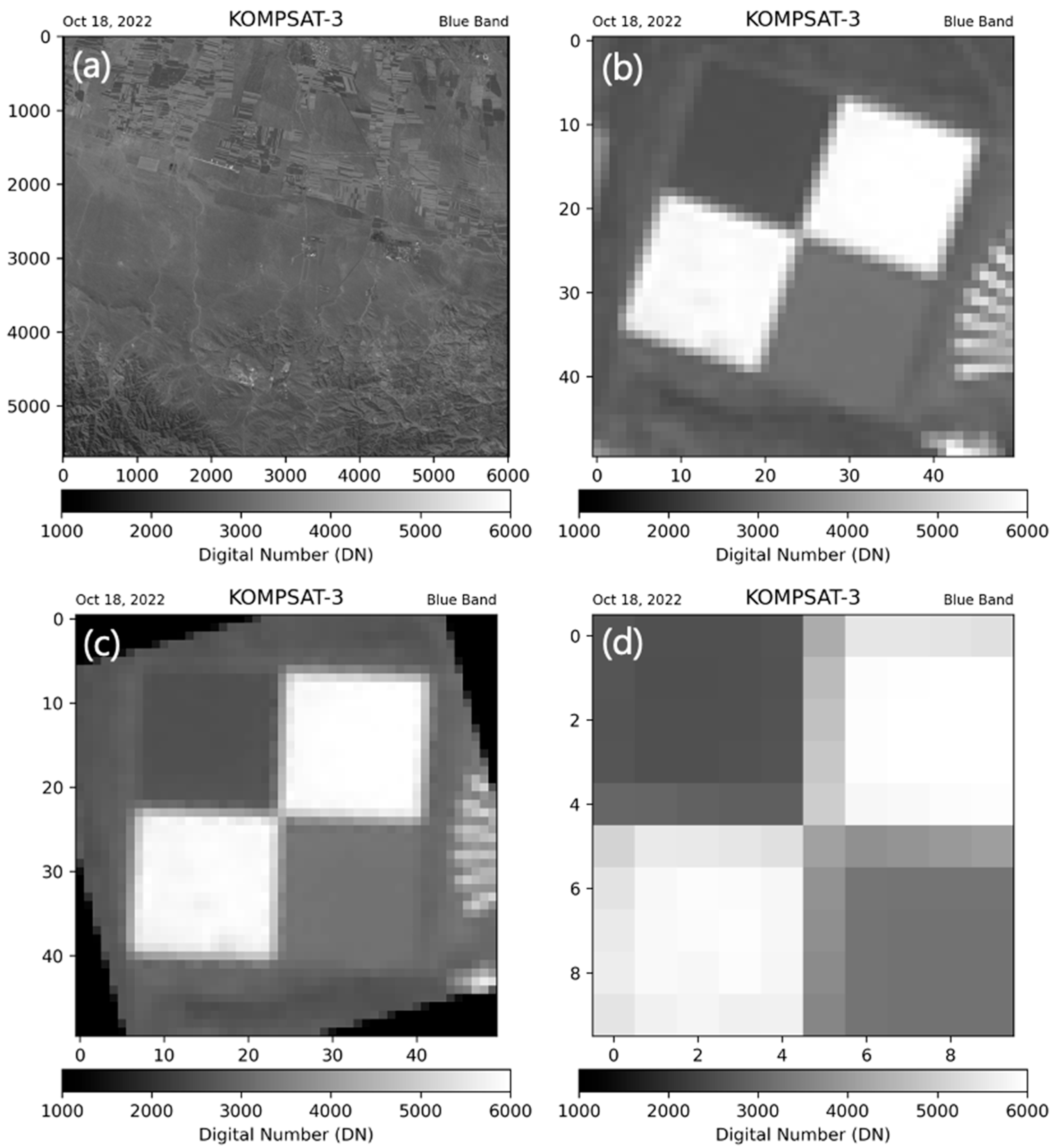
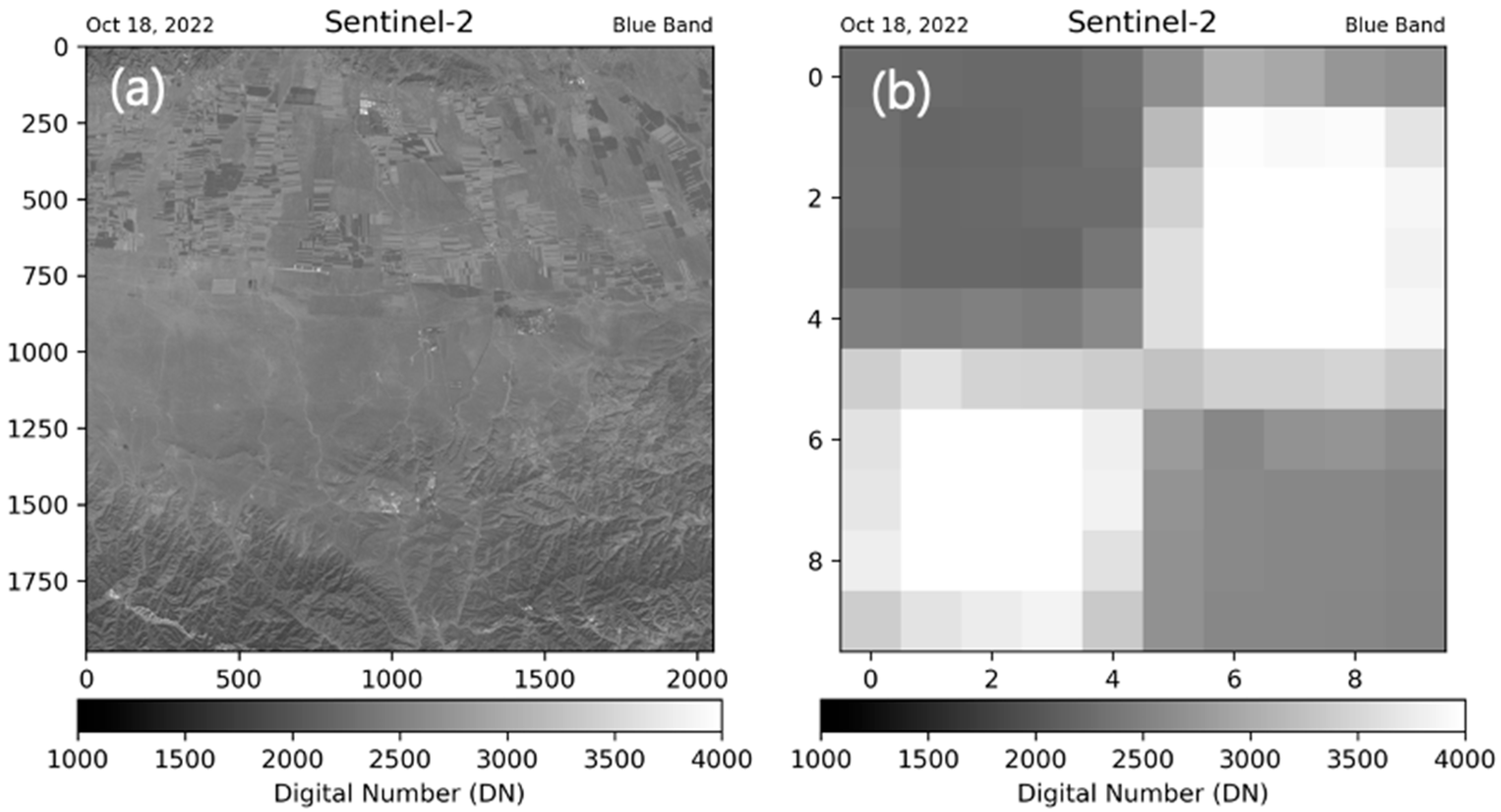
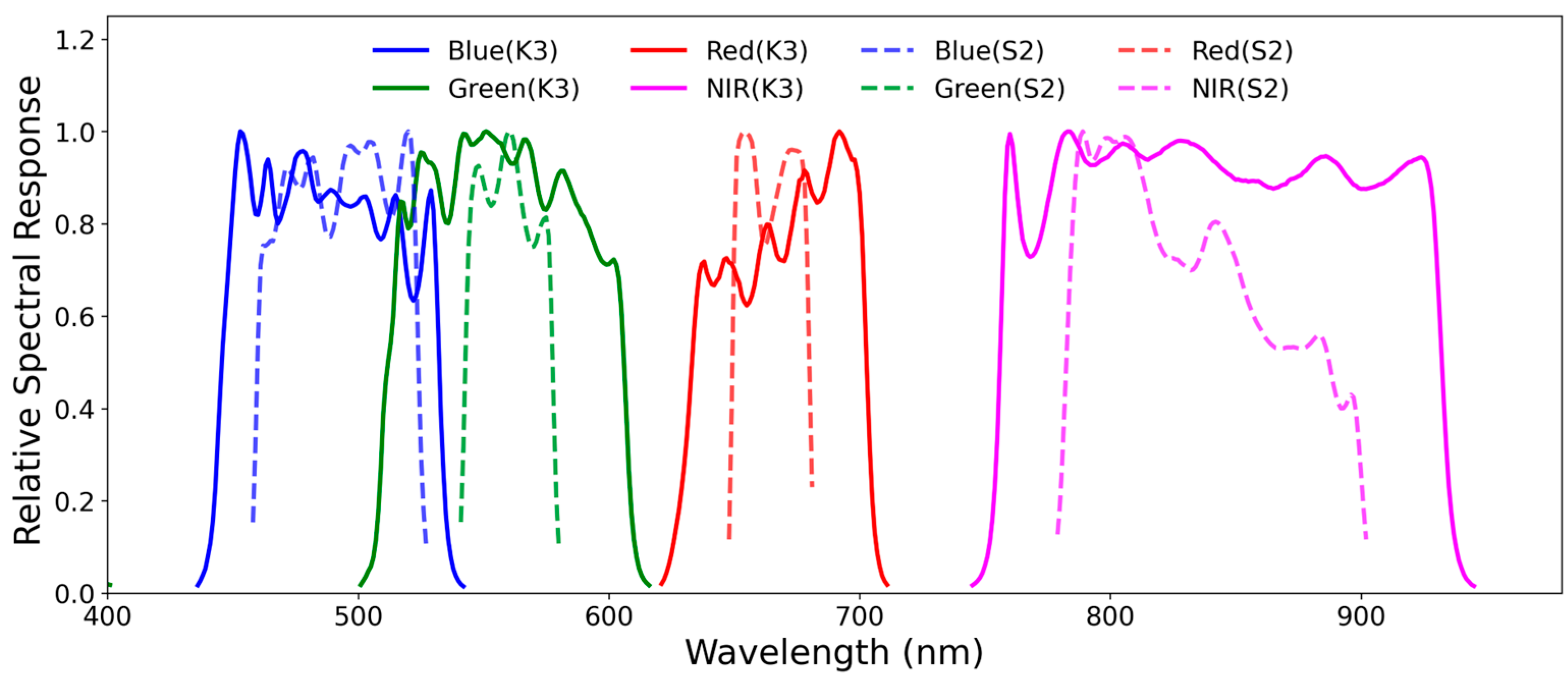
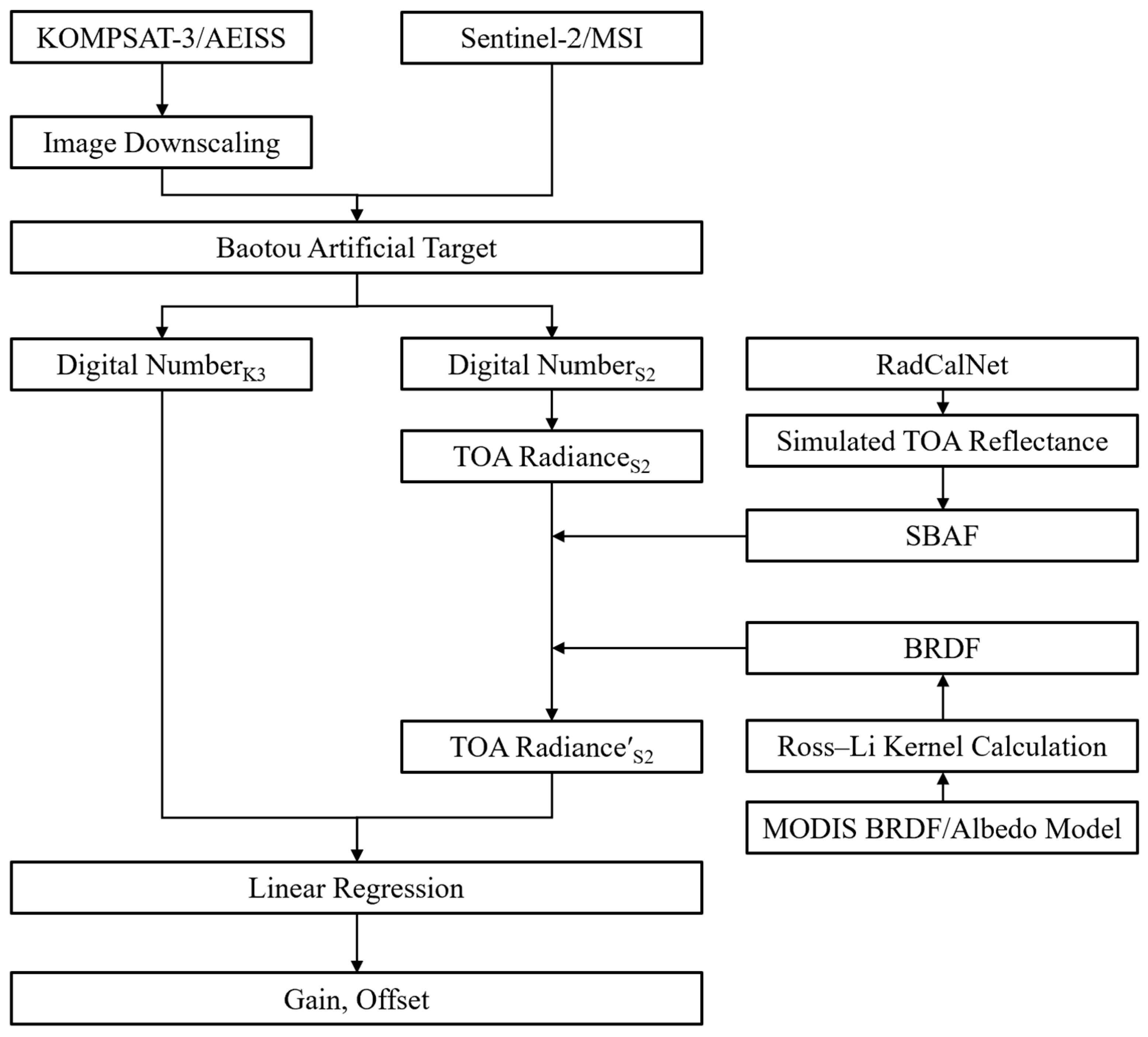
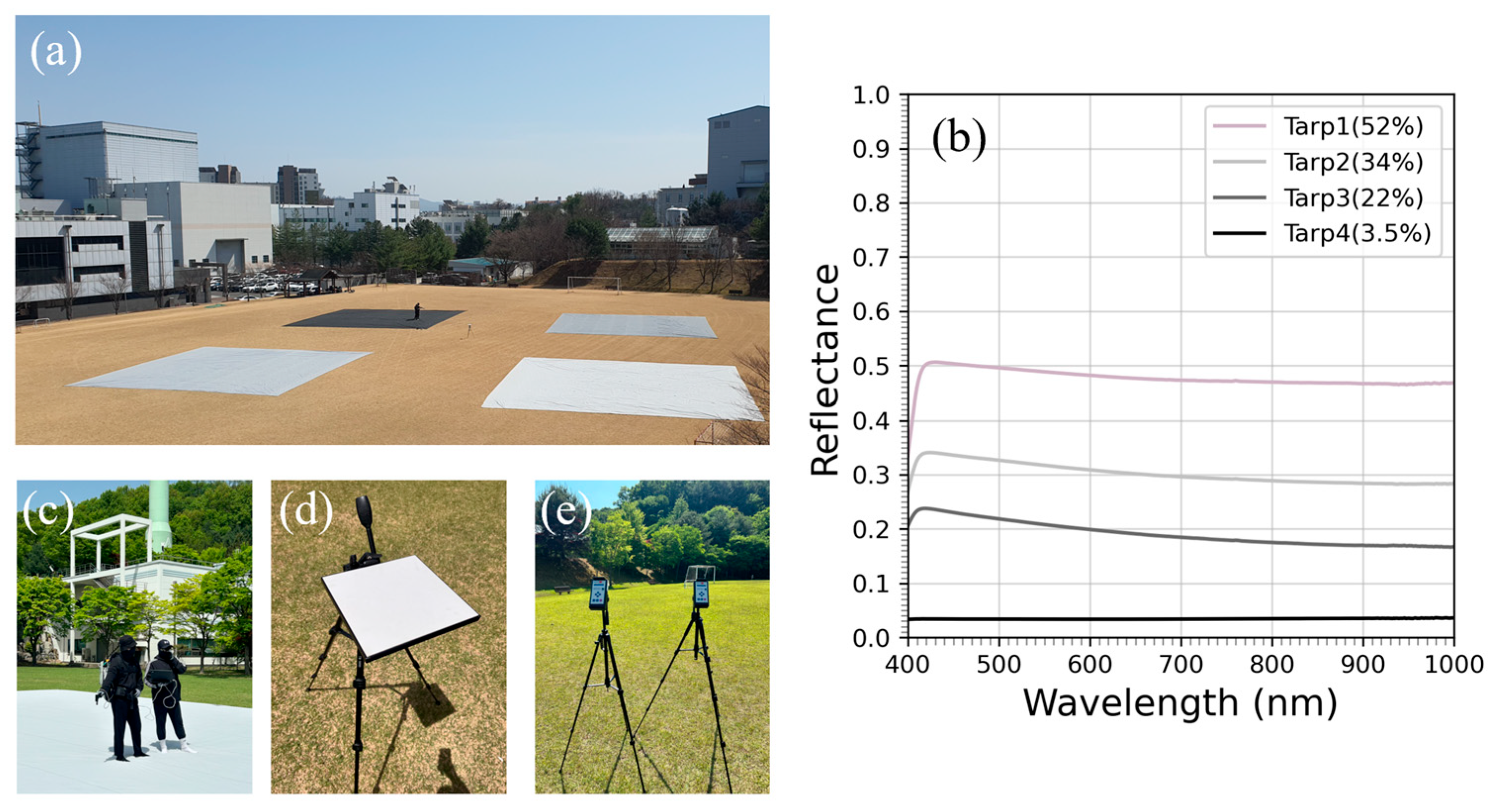
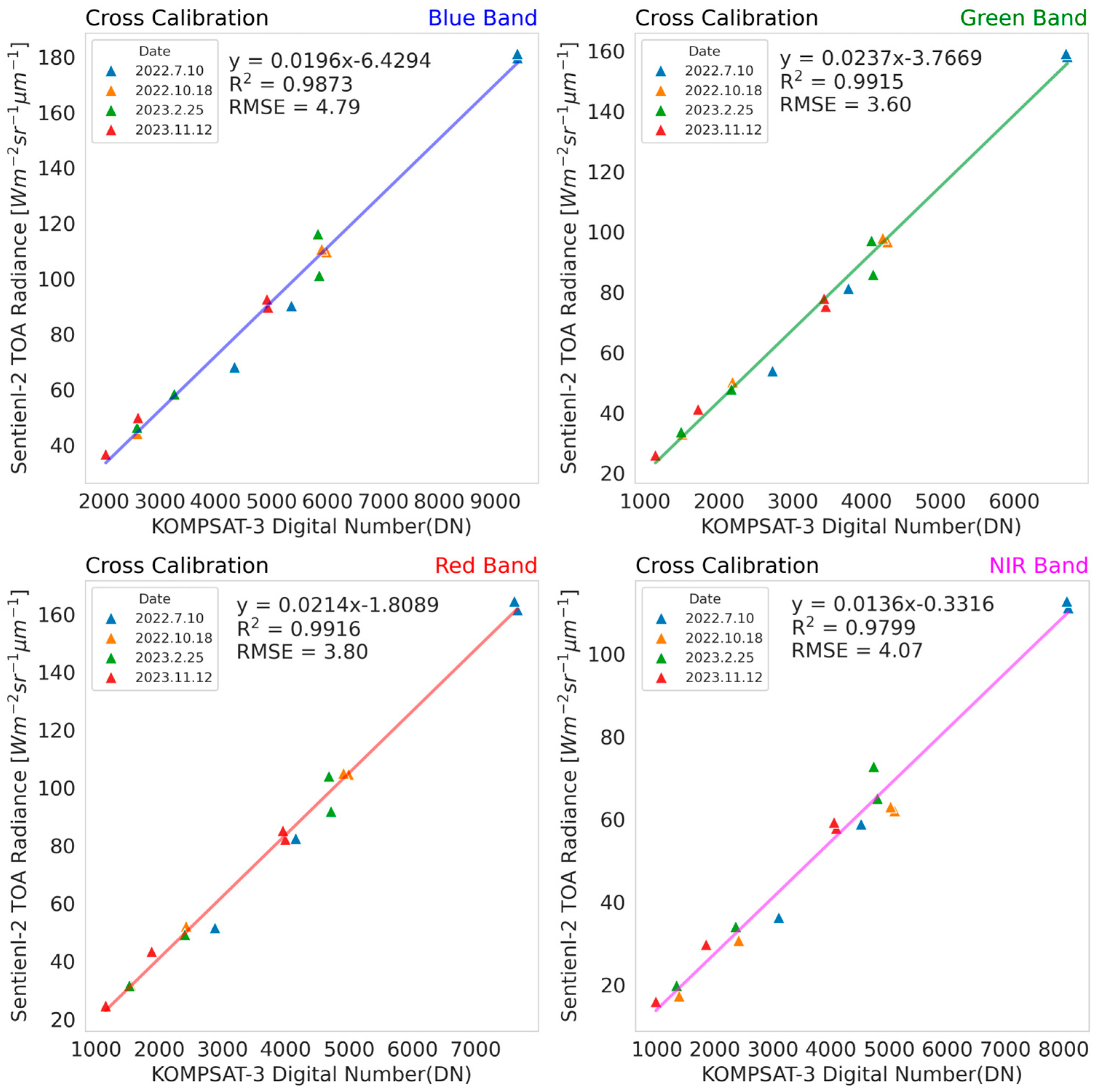
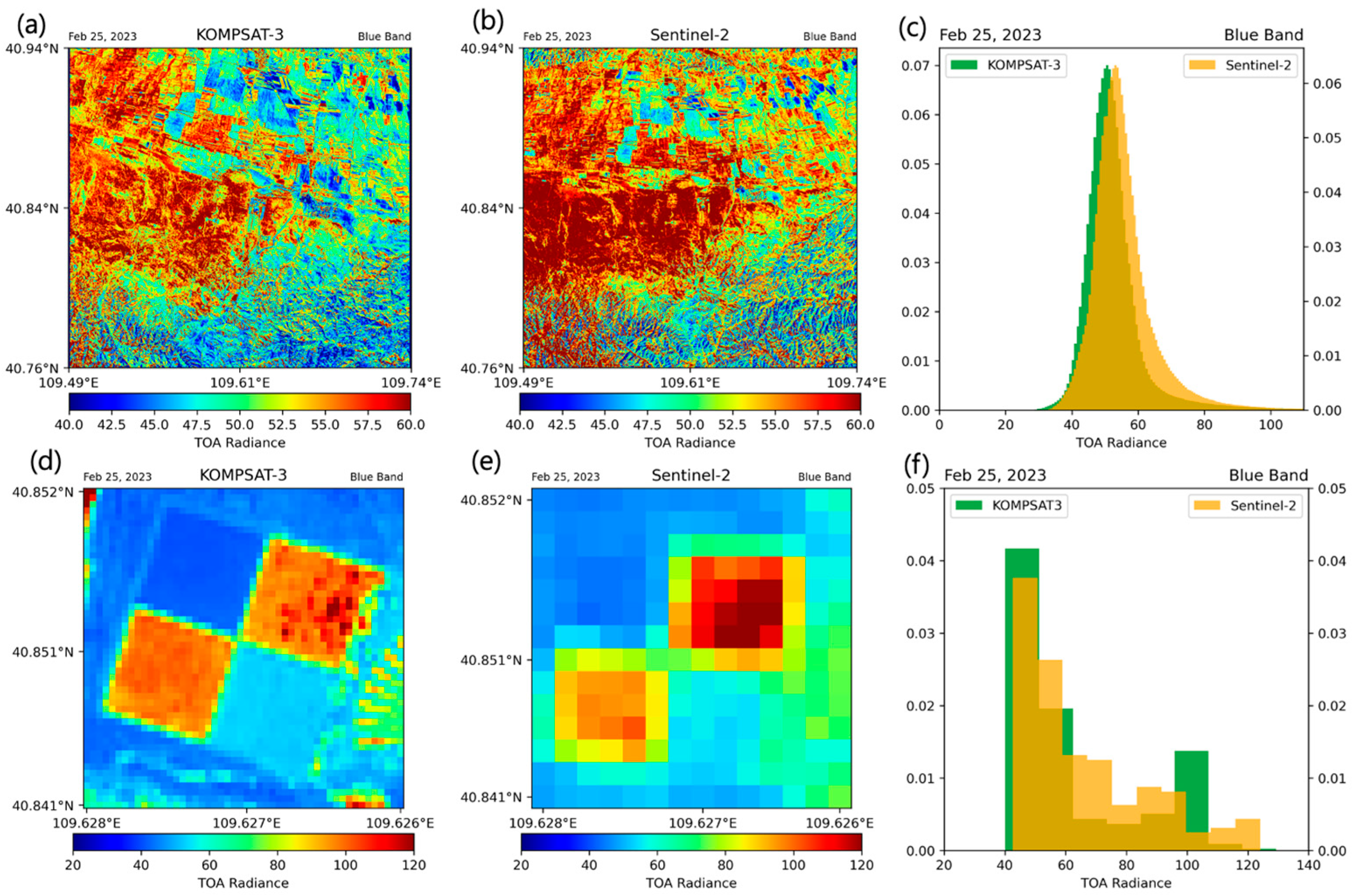

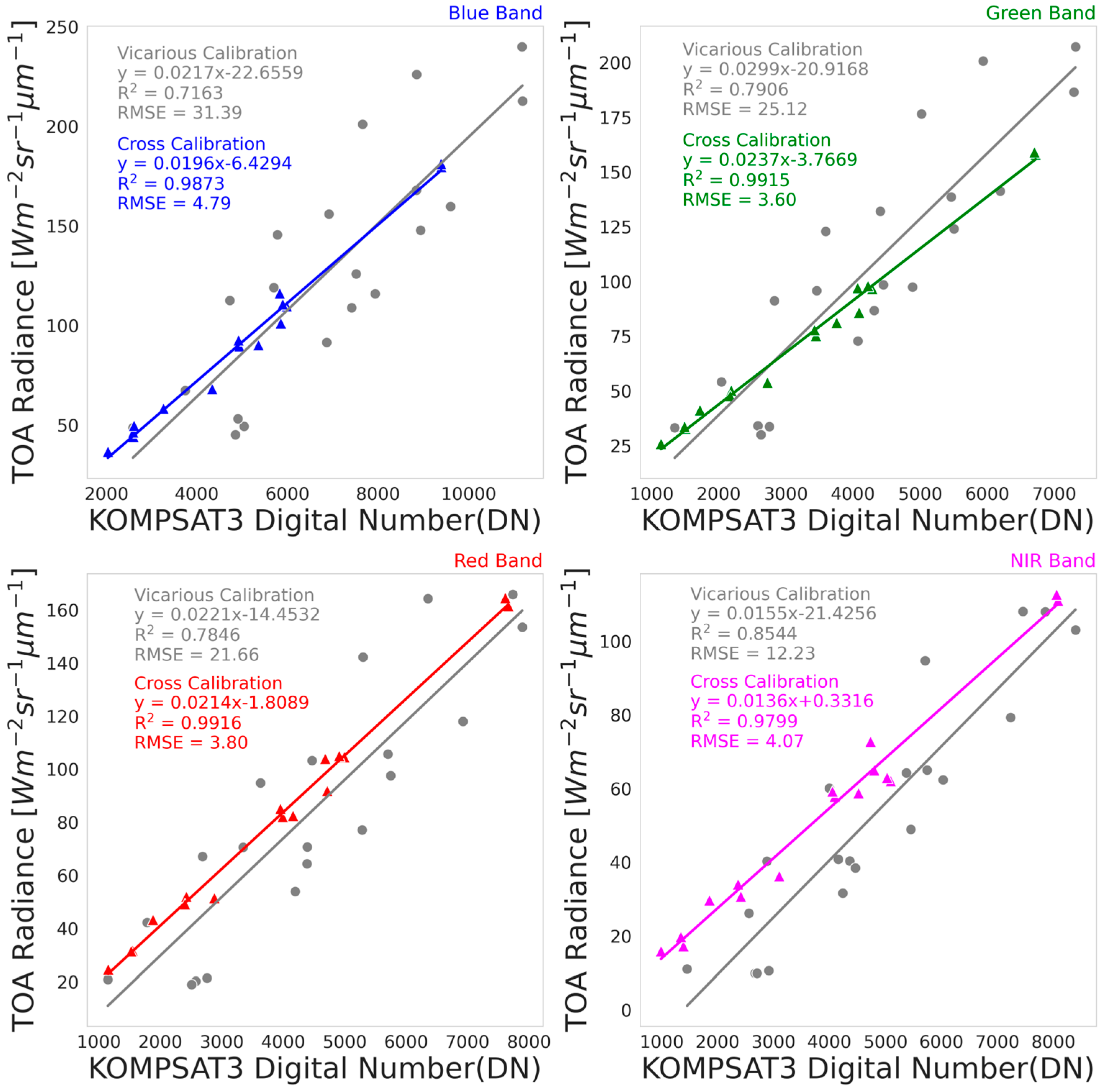

| Mission Characteristic | KOMPSAT-3/AEISS | Sentinel-2A/MSI |
|---|---|---|
| Orbit Altitude | 685 km | 786 km |
| Swath width | 15 km (at nadir) | 290 km |
| Ground Sample distance | MS: 2.8 m | MS: 10 m |
| Spectral Bands | Blue: 450–520 nm | Blue: 458–453 nm |
| Green: 520–600 nm | Green: 543–578 nm | |
| Red: 630–690 nm | Red: 650–680 nm | |
| NIR: 760–900 nm | NIR: 785–900 nm | |
| Signal-to-Noise Ratio | >100 for MS | Blue: 154 |
| Green: 168 | ||
| Red: 142 | ||
| NIR: 174 |
| Method | Site | Longitude | Latitude | Altitude |
|---|---|---|---|---|
| Cross-calibration | Baotou | 109.628°E | 40.854°N | 1300 m |
| Vicarious Calibration | KARI | 127.352°E | 36.374°N | 60 m |
| Date | Satellite | Overpass Time (UTC) | Solar Zenith (°) | Solar Azimuth (°) | Viewing Zenith (°) | Viewing Azimuth (°) |
|---|---|---|---|---|---|---|
| 2022.07.10 | KOMPSAT-3 | 5:52:13 | 22.05 | 218.49 | 16.27 | 260.61 |
| Sentinel-2A | 3:46:54 | 22.82 | 140.85 | 6.44 | 285.16 | |
| 2022.10.18 | KOMPSAT-3 | 5:47:36 | 53.66 | 204.82 | 4.43 | 259.68 |
| Sentinel-2A | 3:46:44 | 51.52 | 166.94 | 6.28 | 284.78 | |
| 2023.02.25 | KOMPSAT-3 | 5:49:28 | 51.59 | 197.54 | 2.13 | 259.58 |
| Sentinel-2A | 3:46:39 | 52.73 | 158.31 | 6.37 | 285.06 | |
| 2023.11.12 | KOMPSAT-3 | 5:53:36 | 62.61 | 205.20 | 10.49 | 278.20 |
| Sentinel-2A | 3:46:41 | 59.39 | 168.84 | 6.38 | 284.96 |
| Band | BRDF Correction Factor | |||
|---|---|---|---|---|
| 2022.07.10 | 2022.10.18 | 2023.02.25 | 2023.11.12 | |
| Blue | 1.06 | 0.98 | 1.04 | 0.99 |
| Green | 1.07 | 1.00 | 1.04 | 0.97 |
| Red | 1.07 | 1.01 | 1.05 | 1.00 |
| NIR | 1.05 | 1.01 | 1.05 | 0.99 |
| Date | Overpass Time (UTC) | Solar Zenith (°) | Solar Azimuth (°) | Viewing Zenith (°) | Viewing Azimuth (°) | AOD (550 nm) | Water Vapor (g/cm2) | O3 (DU) | Cloud Cover |
|---|---|---|---|---|---|---|---|---|---|
| 2023.03.08 | 04:38:43 | 53.14 | 209.47 | 5.96 | 24.86 | 0.50 | 0.86 | 356.85 | 0 |
| 2023.03.21 | 04:46:31 | 57.22 | 215.28 | −22.20 | 9.87 | 0.15 | 0.67 | 328.08 | 0 |
| 2023.03.26 | 04:41:51 | 31.40 | 217.75 | 13.04 | 22.86 | 0.26 | 0.39 | 371.59 | 3 |
| 2023.05.16 | 04:30:50 | 22.31 | 242.14 | 1.39 | 22.66 | 0.40 | 1.41 | 351.22 | 0 |
| 2023.10.05 | 04:43:26 | 47.88 | 217.48 | −6.73 | -0.15 | 0.07 | 0.63 | 281.39 | 0 |
| Blue | Green | Red | NIR | |
|---|---|---|---|---|
| Cross Calibration | 0.0196 | 0.0237 | 0.0214 | 0.0136 |
| Ahn et al. (2017) [14] | 0.0177 | 0.0252 | 0.0214 | 0.0153 |
| Jin et al. (2021) [24] | 0.0179 | 0.0255 | 0.0216 | 0.0130 |
| Blue | Green | Red | NIR | |
|---|---|---|---|---|
| Vicarious Calibration | 0.0217 | 0.0299 | 0.0221 | 0.0155 |
| Ahn et al. (2017) [14] | 0.0181 | 0.0254 | 0.0202 | 0.0130 |
| Yeom et al. (2018) [13] | 0.0275 | 0.0382 | 0.0294 | 0.0192 |
| Site | Band | TOA Reflectance | Difference | Percentage Difference (%) | |
|---|---|---|---|---|---|
| KOMPSAT-3/AEISS | Sentinel-2A/MSI | ||||
| Baotou Sand (40.87°N, 109.62°E) | Blue | 0.154 ± 0.009 | 0.157 ± 0.007 | −0.003 | −1.77% |
| Green | 0.163 ± 0.007 | 0.183 ± 0.010 | −0.020 | −12.57% | |
| Red | 0.241 ± 0.009 | 0.240 ± 0.012 | 0.001 | 0.43% | |
| NIR | 0.263 ± 0.014 | 0.283 ± 0.011 | −0.020 | −7.56% | |
Disclaimer/Publisher’s Note: The statements, opinions and data contained in all publications are solely those of the individual author(s) and contributor(s) and not of MDPI and/or the editor(s). MDPI and/or the editor(s) disclaim responsibility for any injury to people or property resulting from any ideas, methods, instructions or products referred to in the content. |
© 2025 by the authors. Licensee MDPI, Basel, Switzerland. This article is an open access article distributed under the terms and conditions of the Creative Commons Attribution (CC BY) license (https://creativecommons.org/licenses/by/4.0/).
Share and Cite
Choi, J.-H.; Jin, K.-W.; Cha, D.-H.; Choi, K.-B.; Jo, Y.-H.; Kim, K.-N.; Kang, G.-B.; Shin, H.-Y.; Lee, J.-Y.; Kim, E.; et al. Radiometric Cross-Calibration and Validation of KOMPSAT-3/AEISS Using Sentinel-2A/MSI. Remote Sens. 2025, 17, 3280. https://doi.org/10.3390/rs17193280
Choi J-H, Jin K-W, Cha D-H, Choi K-B, Jo Y-H, Kim K-N, Kang G-B, Shin H-Y, Lee J-Y, Kim E, et al. Radiometric Cross-Calibration and Validation of KOMPSAT-3/AEISS Using Sentinel-2A/MSI. Remote Sensing. 2025; 17(19):3280. https://doi.org/10.3390/rs17193280
Chicago/Turabian StyleChoi, Jin-Hyeok, Kyoung-Wook Jin, Dong-Hwan Cha, Kyung-Bae Choi, Yong-Han Jo, Kwang-Nyun Kim, Gwui-Bong Kang, Ho-Yeon Shin, Ji-Yun Lee, Eunyeong Kim, and et al. 2025. "Radiometric Cross-Calibration and Validation of KOMPSAT-3/AEISS Using Sentinel-2A/MSI" Remote Sensing 17, no. 19: 3280. https://doi.org/10.3390/rs17193280
APA StyleChoi, J.-H., Jin, K.-W., Cha, D.-H., Choi, K.-B., Jo, Y.-H., Kim, K.-N., Kang, G.-B., Shin, H.-Y., Lee, J.-Y., Kim, E., Chang, H., & Lee, Y. G. (2025). Radiometric Cross-Calibration and Validation of KOMPSAT-3/AEISS Using Sentinel-2A/MSI. Remote Sensing, 17(19), 3280. https://doi.org/10.3390/rs17193280







